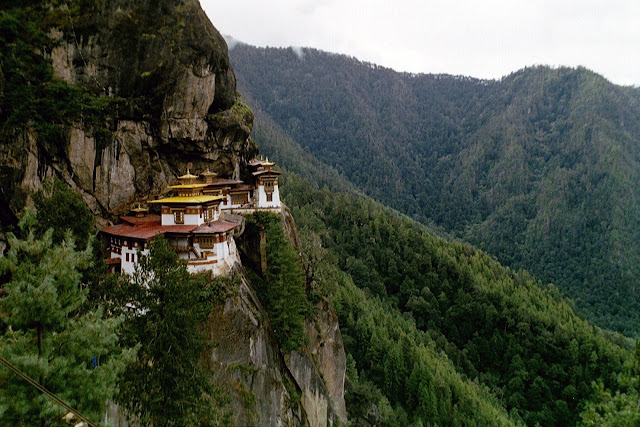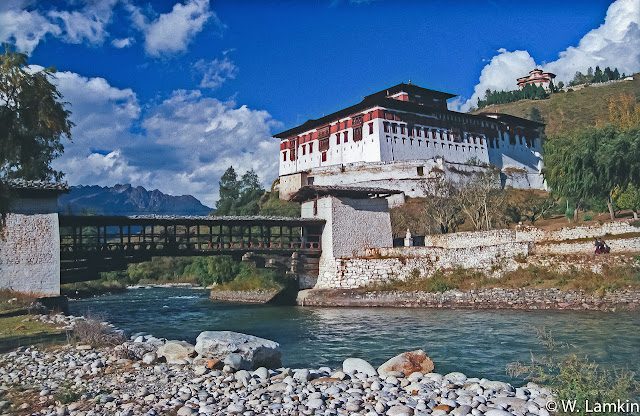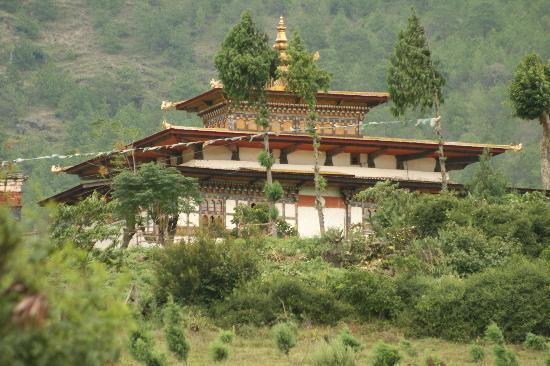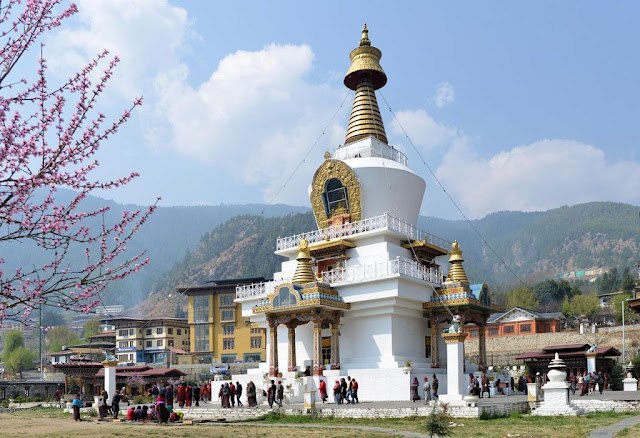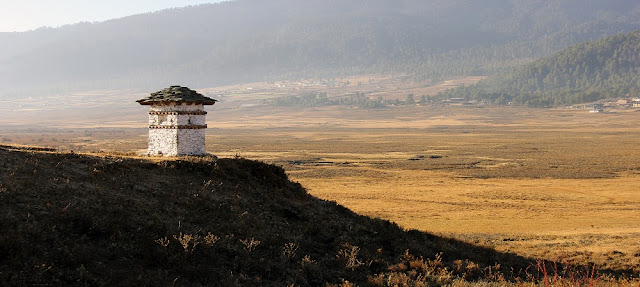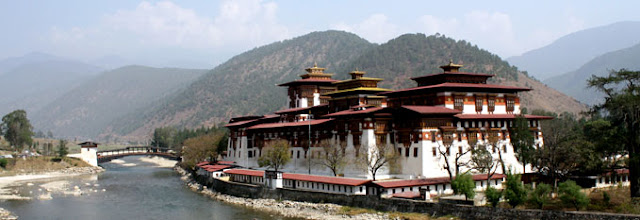Bhutan is a
spot loaded with heaps of amusement exercises and things to do, however here we
will brief you about main 10 best places to visit. Bhutan is renowned for its
lovely treks, exceptional society, normal sights and significantly more. You
can investigate all the astounding Bhutan places in our Bhutan Tour Packages
Here
is selected list of best Places in Bhutan
Taktsang Monastery
Taktsang is
situated on a high bluff towards the north of Paro town. It was first inherent
1692, around the Taktsang Senge Samdup, a cavern where Guru Padmasambhava is
said to have thought for three months in the eighth century. It is trusted that
Guru Rinpoche (Guru Padmasambhava) traveled to this area from Khenpajong, Tibet
on the back of a tigress and repressed an evil spirit. He then performed
contemplation in one of the hollows here and rose in eight incarnated frames
(signs) and favored the spot. Hence, the spot came to be known as the
"Tiger's Nest". Master Padmasambhava is known for acquainting
Buddhism with Bhutan. Today, Paro Taktsang is the best known of the thirteen
collapses which he thought.
Roosted on
the high bluffs Taktsang is alluded to as the Tiger's Nest, it has constantly
motivated and awestruck numerous a guest. Excursion to Bhutan is never finished
without moving to Taktsang, says one vacationer. In fact it's valid as the trip
transforms into a journey and tops you off in otherworldly joy. For those not
picking the profound side it is the sensational and the creatively organized
landmark that turns into a climber's joy. Give us a chance to take you to this
superbly set Buddhist relic dangling from a precipice. Feel the invigoration of
the tough move as you climb more than two thousand feet from the valley floor. Visit
Bhutan Honeymoon Packages
Drukgyel
Dzong
Let the
remnants of this dzong let you know a story of how Bhutanese warriors guarded
Bhutan from the trespassers from the north in the seventeenth century. Despite
the fact that to a great extent decimated by flame in 1951, the external
dividers and the focal tower remain a forcing sight. On a sunny morning, treat
yourself with a mind blowing perspective of Mt. Jumolhari from the methodology
street to Drukgyel Dzong.
Rinpung
and Ta Dzong
In the
fifteenth century nearby individuals offered the bluff of Hungrel at Paro to
Lama Drung Gyal, a relative of Pajo Drugom Zhigpo. Drung Gyal constructed a
little sanctuary there and later a five storied Dzong or stronghold which was
known as Hungrel Dzong.
In the
seventeenth century, his relatives, the rulers of Hungrel, offered this post to
the Drukpa heirarch Shabdrung Ngawang Namgyal, in acknowledgment of his
religious and worldly power. In 1644 the Shabdrung destroyed the current Dzong
and established the frameworks of another Dzong. In 1646 the Dzong was
reconsecrated and built up as the authoritative and devout focus of the western
district and it got to be known as Rinpung Dzong.
Punakha
Dzong
Prevalently
known as the Punakha Dzong, Punthang Dechen Phodrang (The Palace of Great
Bliss) was implicit 1637 by the Zhabdrung. The colossal Dzong was harmed 6
times by flame, once by surge and once by a tremor.
On 17
December, 1907, the main lord of Bhutan, Ugyen Wangchuck, was delegated here.
The Machen Lhakhang, a sanctuary inside the Dzong cherishes the embalmed body
of the Zhabdrung who passed away in retreat here in 1651. Dzongchung (or the
little Dzong), worked in 1328 by holy person Ngagi Rinchen can in any case be
seen inverse the principle Dzong. The stupendous Kuenrey (get together
corridor) in Punakha Dzong is interested in the travelers.
Chimi
Lhakhang
Chimi
Lhakhang is an exceptionally mainstream and adored sanctuary that lies on the
outskirts of the fruitful valley of Lobesa, where the fringes of Thimphu,
Punakha and wangduephodrang areas meet. Being devoted to Lama Drukpa Kuenley,
the Divine Madman, the sanctuary is famously thought to be a sanctuary of
richness.
The
National Memorial Chorten
Thimphu's
Memorial Chorten is both a chorten and a sanctuary in one. It involves an
unmistakable spot in the focal point of the principle street close to the south
passage of the city legitimate; movement parts to circumvent it. It was
implicit 1974 to respect the third King, who needed to build a chorten to speak
to the brain of the Buddha, however passed away before beginning that
undertaking.
Tashichhodzong
It is a
Buddhist religious community and post on the northern edge of the city of
Thimpu in Bhutan, on the western bank of the Wang chu. It has customarily been
the seat of the Druk desi (or "Dharma Raja"), the leader of Bhutan's
polite government, an office which has been consolidated with the authority
since the making of the government in 1907, and summer capital of the nation.
Phobjikha
Valley and Gangtey Gompa
Gangtey
Goenpa is headed to Tongsa it’s very nearly (Sixty-60 Kilometers) far from
Wangdue and the way is secured by the thick woodlands, essentially made up of
oak trees and Rhododendrons. Gangtey Goenpa is the main Nyingmapa cloister in
western Bhutan and is arranged on an edge sitting above the Phobjikha Valley.
As per a legend Gangtey Goenpa was established by the grandson of Pema lingpa,
Gyalse Pema Thinley in 1613 and later was extended by Tenzin Legpau Dhendup. It
is at present experiencing a noteworthy redesign booked to be finished by 2008.
Phobjikha is
a chilly valley on the outskirts of the north western tip of the Black Mountain
National Park at the height of 9,840 feet. The valley is a wide, lovely high
wetland valley and is a preservation region and lies on the northern limit of
the Jowo Durshing range. The slope side vegetation is for the most part pine
woodland, mixed with Rhododendron trees. Phobjikha valley is likewise one of
the perching grounds of the Black-necked cranes that move every year in winter
from its northern living spaces in Tibet and Siberia. These rich and bashful
winged animals can be seen from early (Nov to end of the Mar). RSPN and
Phobjikha people group are currently cooperating to ensure the living space of
jeopardized Black Necked Cranes.
Dochula
Pass
Bhutan the
Land of Thunder mythical serpent is encompassed by Beautiful Mountains and
ignores all. Being in the Himalayan zone Bhutan has the most excellent
mountains in Jumolhari , Jichu drakay and Kula Gangir which lies in the Northen
Part and flanked to China. Dochula Pass which is the most known go in the
Bhutan is only (30 odd kilometers) drive from the Capital City Thimphu in
transit towards focal Bhutan. Dochula pass is around 3150 meter from ocean
level and it's for the most part secured with white mists, where on a sunny
morning you can see awesome perspective of the strong Himalayas mountain
ranges. Dochula pass serves the stop for all the bystander flying out forward
and backward to punakha and wandgi for some espresso all around served from the
Dochula Cafeteria found simply over the Beautiful Dochula Pass.
Kurje
Lhakhang
